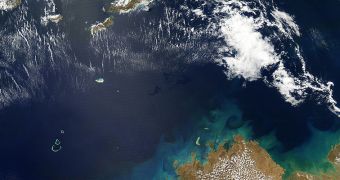Experts at the World Wildlife Fund (WWF) Australia congratulate authorities on the release of a report concerning the effects and responsibilities associate with the large 2009 oil spill that occurred in Timor.
The spill started on August 21, 2009, when the West Atlas drilling rig is owned by the Norwegian-Bermudan company Seadrill, blew a wellhead on the Montara oil platform. Seadrill is a subsidiary of the Thai state-owned oil and gas company.
Officials estimate that during the peak oil flow from the ruptured wellhead, as much as 2,000 barrels of crude were spilling into the Timor Sea, which is located off the northern coast of Western Australia.
The environmental disaster covered an area of about 6,000 square kilometers, or around 2,300 square miles, although some sources seem to suggest that the affected region was a lot larger.
Large oil slicks covered significant sections of critically-important ecosystems, including a large number of coral reef populations. Reef-based marine species were also severely affected.
The spill continued until November 3, 2009, when the company that operated the rig, PTT Exploration and Production Australasia (PTTEPAA), managed to deliver some 3,400 barrels of mud into a relief well.
The measure, which was successful in stopping the leak, was the fifth for the company. In the mean time, between 1.2 and 9 million gallons of crude spilled into the delicate ecosystem.
Identifying the people and companies that were at fault and needed to account for the disaster was the object of the new report. WWF Australia played a large role in getting a team of experts to compile it.
The document revealed “widespread and systematic” shortcomings in the methods PTTEPAA used to construct and operate the drilling rig and the well.
One of the companies involved in constructing and cementing the Montara platform wellhead was Halliburton, the world's second largest oilfield services corporation.
As the report was released, the WWF called on the federal government “to get serious about protecting Australia’s oceans and coasts, [by using] a network of marine sanctuaries that prevent drilling for oil and gas in the most environmentally sensitive areas.”
Another culprit that was identified as responsible was the Northern Territory Department of Resources, which apparently “was not a diligent regulator, and its minimalist approach to its regulatory responsibilities gave it little chance of discovering these poor (company) practices.”
“When WWF visited the toxic spill last year, it was evident dolphins and sea birds were swimming through a noxious mix of oil and chemical dispersants,” explains WWF Australia conservation manager Dr Gilly Llewellyn.
“This kind of environmental disaster is unacceptable. Montara and the Gulf of Mexico spill have shown the worse case scenario can and does happen,” she concludes.

 14 DAY TRIAL //
14 DAY TRIAL //